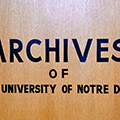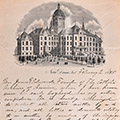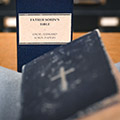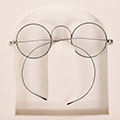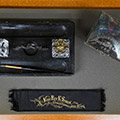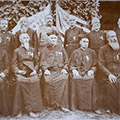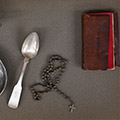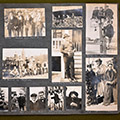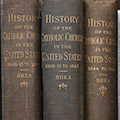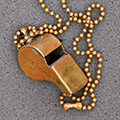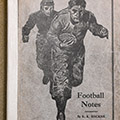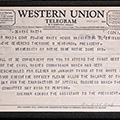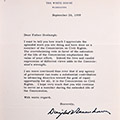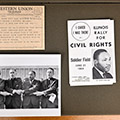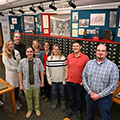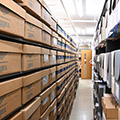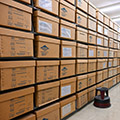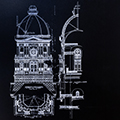University of Notre Dame Archives joins the Hesburgh Libraries

MILESTONE 52 — In January 2016, the University of Notre Dame Archives joined the Hesburgh Libraries. An official announcement in NDWorks followed in April.
The move, which integrated the Archives into the Library's organizational structure, aimed to further enhance collaboration and resource use, allow easier access to important materials, and assist in making the University’s world-class collections available to scholars on campus and worldwide.
“We are pleased to welcome the University Archives into the Hesburgh Libraries family,” said former Edward H. Arnold University Librarian Diane Walker in a press release announcing the change. “Our units have collaborated throughout the years on many projects in service of the University, and this arrangement will allow the archivists, librarians, and staff to leverage combined expertise in areas such as digital projects, traditional and digital preservation, collection management, and global discovery.”
After the announcement was made in 2016, University Archivist Wendy Clauson Schlereth, who had directed the Archives since 1978, focused exclusively on archival projects and papers of officers who were members of the Congregation of Holy Cross. Clauson Schlereth retired at the end of 2017 after nearly 40 years of service, and Charles Lamb became interim director and assumed the day-to-day operations of the Archives.
“Together with the Hesburgh Libraries, the Archives will continue to make its important historical materials and world-class collections available to scholars at Notre Dame and around the world for years to come,” said then Vice President and Senior Associate Provost Chris Maziar.
What is the University Archives
The University Archives collects, preserves, and makes accessible the official records of the University of Notre Dame. Its approximately 65,000 cubic feet of collections contain the official administrative documents of the University as well as the personal papers of notable individuals throughout the institution’s history.
The history of the Archives dates back to the University’s earliest days when founder Rev. Edward Frederick Sorin, C.S.C., recognizing the importance of preserving items of significance for the historical record, directed that the University’s charter should "remain in the Archives as the most precious monuments that could be in its possession.” (The Chronicles of Notre Dame du Lac)
The Archives went on to be shaped by James F. Edwards, who came to Notre Dame in 1859 at nine years old, and remained until his death fifty-two years later. Interested in the American Catholic hierarchy, he began collecting items as an undergraduate. With a vision to create Bishop’s Memorial Hall, Edwards worked to obtain a vestment, portrait, and manuscript from every bishop in the United States. He also willingly accepted any papers the bishops would turn over. These papers became some of the first manuscript collections held in what he called “The Catholic Archives of America.”
After Edwards’ death in 1911, his successors, including Rev. Thomas McAvoy, C.S.C, continued building and organizing the Archives. Manuscript collections began to develop, documenting the Catholic experience outside North America. Microfilm was introduced into the Archives to expand records of European mission societies and the Congregation for the Propagation of the Faith in the Vatican.
Rev. Thomas Blantz, C.S.C., expanded the institutional archive to individual record retention and correspondence of the University’s presidents. Understanding that these records needed to be treated differently than manuscripts, Blantz designated administrative record groups as an official component of the Archives’ holdings.
When Clauson Schlereth took over the Archives in 1978, she hired a staff trained in archival administration and continued organizing the records and implementing records management practices.
The Collections
Today, the University Archives holds more than 1,600 different collections. It is recognized as one of the nation’s foremost archival repositories for studying American Catholicism. It has collected and maintained records, papers, photos, and other materials documenting the Catholic Church in America since the early 19th century.
In addition to collections documenting the Catholic Church, the Archives also manages the official records of the University of Notre Dame, which include the University’s extensive athletics collection.
“Early records from the twenties, thirties, and forties weren't really maintained by institutions for their historic or enduring value,” said Patrick Milhoan, interim program director for specialized collections and services and head archivist for the University Archives. “It's unique that Notre Dame has such a deep collection. You can draw parallels to other national events through the athletics collection and see the growth of collegiate athletics through the lens of the University of Notre Dame.”
He also cites the University photography collection.
“We can glimpse into campus life at any point in the University's history,” he says. “What was student life like in the 1920s? What was it like during the 1940s when the University engaged with the United States Navy to develop an ROTC program? You can really see the impact and change at Notre Dame over time.”
The Archives today
As times have changed, so have the Archives. Over the years, photographs, records of sports and life on campus, and materials produced by new technology have been added to the holdings.
“As archivists, it is our duty and obligation to preserve the integrity of modern digital records,” said Milhoan. “The expertise of the Archives team has lent itself well to propel these efforts forward.”
Eight years after their integration, Milhoan sees the Archives and the Libraries working in synergy to further teaching and research.
“We have many members here who work across departments,” he said. “They tackle things such as digital asset management, teaching excellence, and even help to develop standards for collections strategy directly related to diversity, equity, and inclusion.”
He gives the example of the University Archives' joint classes with Rare Books and Special Collections. “We select items from both collections and leverage those assets to advance or support a particular topic,” he said. “Coming together creates a higher value for the students, faculty, and the global scholarly community.”
In addition to teaching classes, the Archives partner with faculty across campus to showcase their collections and holdings directly relevant to their curriculum.
The University Archives also works with scholars outside of the University by fielding requests from researchers around the world.
“We welcome researchers from all walks of life,” Milhoan said. “Regardless of what pursuit they're undertaking.”
